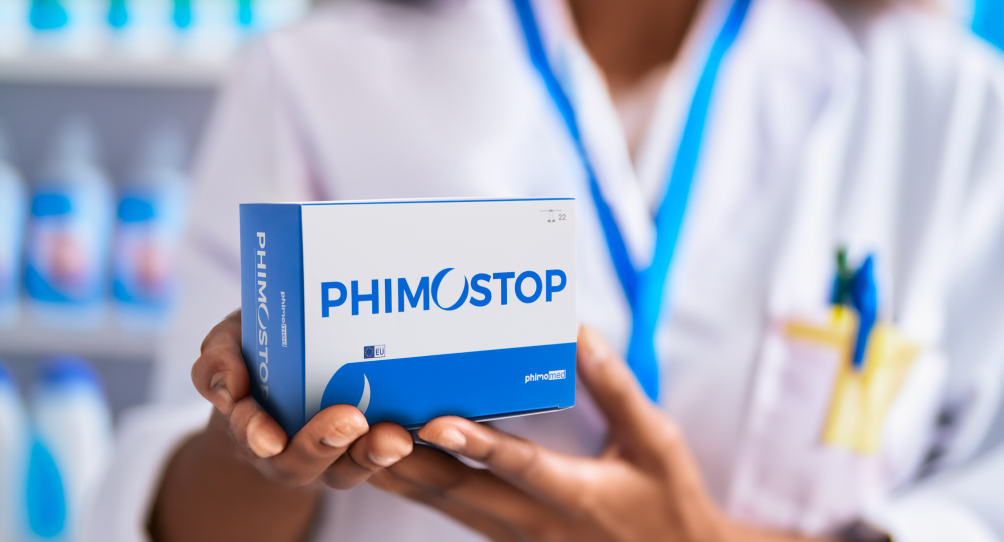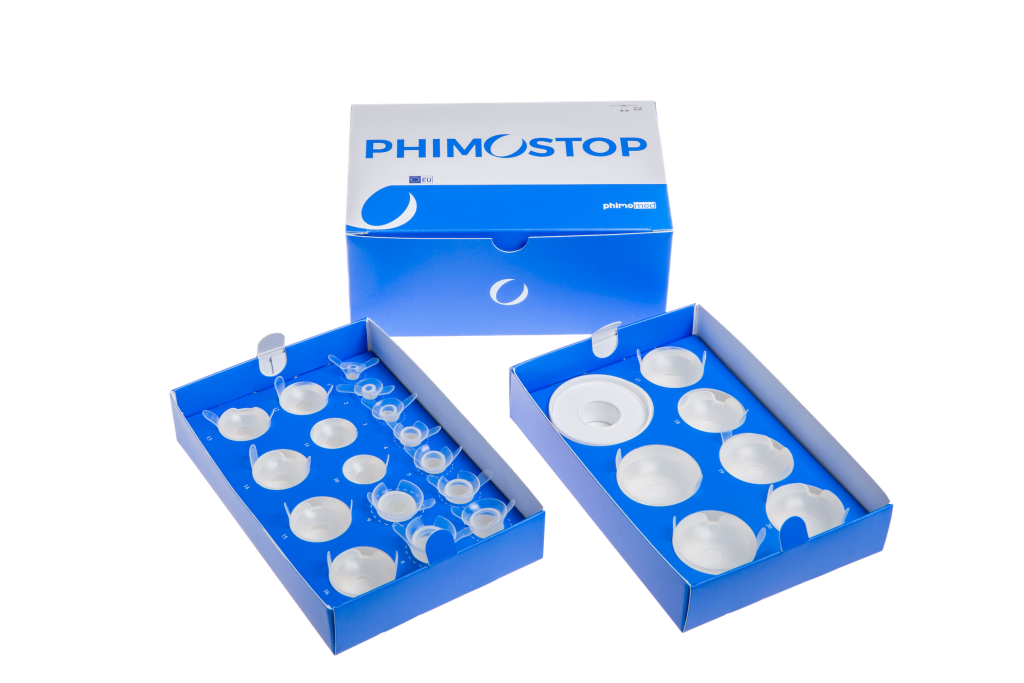How to use Phimostop phimotic ring stretcher
Phimosis is a condition in which the foreskin of the penis is tight, preventing full retraction of the glans and causing possible problems during urination or sexual intercourse. In most cases, circumcision with local anesthesia is recommended to treat phimosis in adults. While surgery is certainly a definitive solution, it does not take into account the psychological implications that the patient must face before having part of his penis removed.
This is why it is important to propose alternative ways before resorting to surgical treatment such as, for example, Phimostop that, thanks to 22 medical silicone elements, is designed and manufactured to apply the established technique of skin dilation to the phimotic ring when subjected to progressive and constant pressure.

What's on this page:
What is phimosis ring
Phimosis can be caused by scarring or narrowing of the phimotic ring, which can be painful and cause difficulty during urination or sexual intercourse.
The phimotic ring is the part of the phimotic tissue with inelastic cells that is created around the foreskin after an infection, especially in cases of acquired phimosis. Following an infection, in fact, a ring of increasingly inelastic cells begins to form on the foreskin, which over time can stiffen to create a real noose around the glans.
In the worst cases, there is “strangulation” of the glans so severe that emergency surgery is needed: in these cases we speak of paraphimosis. Paraphimosis occurs when the foreskin, once retracted behind the glans, cannot be returned to its original position. This situation can cause difficult blood circulation in the glans and lead to edema or potential complications if not treated promptly.
PHIMOSTOP
Treating Phimosis without Circumcision
Phimostop is a medical device consisting of 22 medical silicone elements designed to help resolve phimosis, a condition in which the foreskin cannot be fully retracted onto the glans of the penis.
Phimosis stretching exercises: why avoid home made methods
Frequently, in cases of non-tight phimosis, the patient tends to intervene on his own by trying to force the foreskin – sometimes with the use of phimosis ointments – but achieving the opposite effect.
Forcing the phimotic ring, in fact, can create small tears that can become infected and go on to make the phimotic tissue even harder.
For this reason, the use of autonomous, homemade therapies that only risk making the situation worse should be avoided at all costs. Instead, by consulting a physician and intervening early, it is possible to stop the growth process of the phimotic tissue and witness a total regression of the phimotic ring.
It is always advisable to consult a physician and evaluate the actions to be taken to solve the problem.
Phimosis kit: how to cure phimosis with Phimostop
Phimostop is a medical device designed to cure phimosis without circumcision surgery. It is a phimotic ring stretcher with 22 medical silicone elements designed and manufactured to apply the proven technique of skin dilation to the phimotic ring when subjected to progressive and constant pressure.
Before putting it on, wash your hands and the tuboid with soap and water; you can leave the tuboid moist to facilitate insertion and, if necessary, grease the mouth of the foreskin with lubricating creams (take care not to lubricate the outside of the foreskin).
How to insert the tuboids 1-9:
- Lower the foreskin as far as possible (do not force)
- Insert the tuboid with a slight rotation and rest the base on the glans
- Rotate the tuboid thus inserting the entire base
- Using thumb and forefinger, pull up the skin (inner and outer) of the foreskin to under the wings
- Lower the wings and fix with the supplied plaster (to be cut off)
How to insert tuboids 10-22:
- Lower the foreskin as far as possible (do not force)
- Place the base of the tuboid on the glans
- With thumb and forefinger pull up the skin (inner and outer) of the foreskin to under the wings
- With thumb and forefinger pull up the skin (inner and outer) of the foreskin
- Lower the wings and fix with the supplied plaster (to be cut)
- As the phimotic ring expands you can move on to the next tuboid; it is very important to use as many tuboids as necessary without skipping any steps.
The process ends when the foreskin is able to descend to the base of the glans without squeezing and flows freely even in an erect state (it is not always necessary to go all the way to the last tuboid).
It is necessary to hold the tuboid 24 hours a day or at least 12 hours a day and wear the same tuboid for at least 2 to 5 days depending on the type of phimosis. The transition to the next tuboid can be made when the tuboid enters without pain, otherwise the previous tuboid must be held longer.
Finally, with the Phimostop tuboid inserted it is possible to carry out any type of activity as one does not realize that one is wearing it (e.g. to urinate one does not need to remove the tuboid).
Phimostop: do phimosis rings work?
Phimostop is a medical device validated by the Italian Ministry of Health and the subject of clinical research at the Tor Vergata University Polyclinic in Rome. The clinical research was coordinated by Professor Miano, and the results were published in the international scientific journal “Translational Urology and Andrology”.
For the first study on the efficacy of the Phimostop medical device, 85 patients with mild to moderate phimosis and an indication for circumcision surgery were selected.
The goal set by the study was to avoid circumcision for one third of the patients selected for the study: this goal was largely met and exceeded since more than half of them were able to avoid circumcision surgery after treatment with the Phimostop device. Moreover, 80% of patients would recommend using the device to other patients with phimosis before considering circumcision surgery.
This research was carried out with the old model of Phimostop, which has recently been improved in ergonomics and components-from 13 tuboids to 22.
Phimostop is the only medical device for the treatment of phimosis without circumcision validated by the Ministry of Health.

Want to know more?




